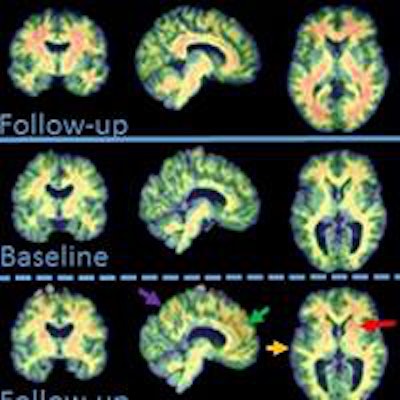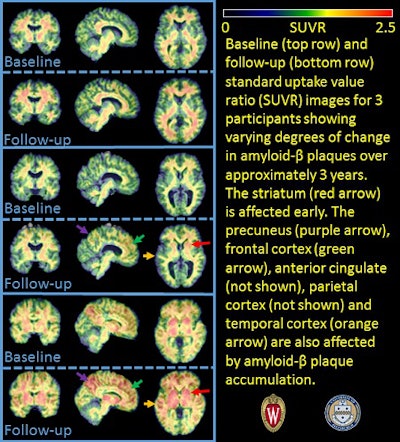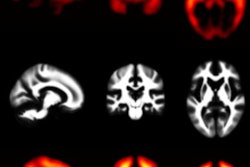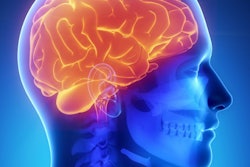
SAN DIEGO - Using carbon-11-labeled Pittsburgh Compound B (C-11 PiB) with PET, researchers have tracked an unusual increase in beta-amyloid plaque in the striatum region of the brain among people with Down syndrome, according to a study presented on Sunday at the Society of Nuclear Medicine and Molecular Imaging (SNMMI) annual meeting.
PiB uptake in the striatum was greater than in surrounding regions such as the anterior cingulate, frontal cortex, precuneus, parietal cortex, and temporal cortex in some of the Down syndrome subjects. Accumulation of beta-amyloid plaque in these areas of the brain can eventually lead to deficiencies in memory, language, and other skills.
"Down syndrome represents a special population which gets the neuropathology of Alzheimer's disease through beta-amyloid plaque, and because they develop the plaque at an earlier age, they eventually get dementia at an earlier age," said lead author Patrick Lao, a PhD student at the University of Wisconsin at Madison. "From the data, we hope to correlate with these biomarkers to see how these changes in beta-amyloid cause changes in cognition."
Down syndrome and Alzheimer's
In his SNMMI presentation, Lao noted that beta-amyloid plaque is known to accumulate with age; however, in an autosomal form of Alzheimer's, people are genetically predisposed to early onset of the disease due to amyloid overproduction. This also includes early involvement of the striatum region of the brain, which is associated with cognitive function.
"Similarly, Down syndrome has a predisposition to Alzheimer's disease due to a triplicate copy of chromosome 21, which holds the amyloid precursor protein gene that also results in an overproduction of amyloid," he said. "[But] the Down syndrome population is unique in that almost all adults show some degree of amyloid by age 40 postmortem, and 80% of the individuals over the age of 60 have dementia."
In the current study, Lao and colleagues followed 79 adults with Down syndrome (age: 30-53 years) who had no signs of dementia. All subjects had a baseline PiB-PET scan, and 43 (54%) so far have had follow-up scans (ECAT Exact HR+, Siemens Healthineers) 2.9 years (± 0.6 years) later.
Standard uptake value ratios (SUVRs) were calculated using data from PET images taken 50 to 70 minutes after PiB injection. Mean SUVR was calculated for the six aforementioned brain regions, and a PiB-positivity threshold was established using a clustering algorithm to assess PiB uptake in the regions of interest versus nearby areas. Subjects were classified as PiB-positive if at least one region of interest was above its respective threshold.
Lao and colleagues targeted these areas of the brain because they are associated with cognition, memory, and other executive functions. Most notably, the regions are where beta-amyloid plaque deposits linked to Alzheimer's are found.
PiB-positive
Among the 43 subjects who underwent both PiB-PET scans, seven were classified as PiB-positive on baseline scans. PiB-positive findings ranged from one region of interest to all six targeted brain regions. Among subjects with only one PiB-positive location, elevated PiB binding was found in the striatum.
"Looking at the baseline scans, you can see there is elevated amyloid in the striatum and the absence of elevated amyloid in any other cortical regions," Lao told AuntMinnie.com. "That suggests that [plaque accumulation] occurs first before the cortical regions."
All seven PiB-positive baseline subjects also showed an increase in PiB SUVR and/or an increase in the number of PiB-positive regions of interest in their follow-up scans. In addition, six subjects who were PiB-negative at baseline advanced to PiB-positive findings on follow-up and were classified as PiB-positive, or "PiB converters."
Changes in SUVR between baseline and follow-up PiB-PET scans among PiB converters were greatest in the striatum, followed by the anterior cingulate, precuneus, parietal cortex, frontal cortex, and temporal cortex.
 Image courtesy of Patrick Lao, PhD.
Image courtesy of Patrick Lao, PhD."What is very interesting about the Down syndrome population is that the striatum accumulates beta-amyloid plaque early, which is different from the general population," Lao said. "It is quite similar to autosomal dominant Alzheimer's disease where there also is early striatum involvement."
The researchers found no evidence of reversible beta-amyloid plaque binding in the subjects, and increases in PiB binding were dependent on the amount of beta-amyloid plaque at baseline, rather than the age of the subject.
"The significance of age is that the Down syndrome population usually gets dementia before the age of 65," Lao added. "So they will start accumulating beta-amyloid plaque earlier and have clinical symptoms earlier than late-onset Alzheimer's disease."
Cognitive connection
The researchers also categorized the subjects into three groups: those who showed no elevated beta-amyloid levels between baseline and follow-up, those with no elevated beta amyloid at baseline but increased PiB uptake at follow-up, and those who had positive PiB findings at both baseline and follow-up.
Study participants also received a battery of neuropsychological tests. In particular, Lao and colleagues used the Peabody Picture Vocabulary Test, which measures receptive language and is known to strongly correlate with IQ but not age.
Preliminary results from the combined analyses of PiB levels and cognitive skills showed no changes in overall performance among Down syndrome subjects with negative PiB-PET results at both baseline and follow-up. There was, however, a decrease in test scores among those who were PiB-negative at baseline but had elevated PiB levels at follow-up. Subjects who were PiB-positive at baseline and at follow-up showed the greatest decline in cognitive skills.
"Studies within the Down syndrome population will provide insight into the trajectory of amyloid accumulation, which will inform future studies about Alzheimer's disease and neuropathology progression, as well as therapy trials for which the Down syndrome population is particularly well-suited," Lao told SNMMI attendees.
The research is part of an ongoing study between the University of Wisconsin and University of Pittsburgh Medical Center that began in 2010 through a grant from the National Institutes of Health.




















